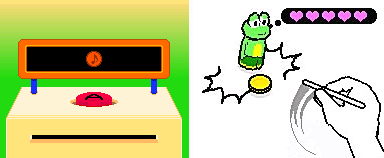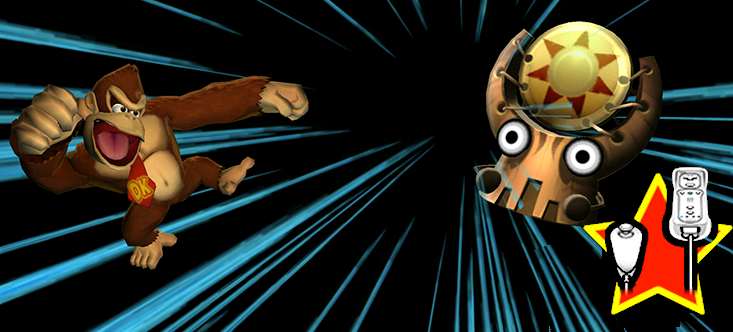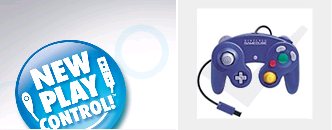Controller Design: Rebuttals pt.11
 Friday, September 2, 2011 at 10:40PM
Friday, September 2, 2011 at 10:40PM part 1. part 2. part 3. part 4. part 5. part 6. part 7. part 8. part 9. part 10.
Rhythm Tengoku vs Gold

Rhythm Tengoku and button controls (left). Rhythm Heaven and flick controls (right).
Rhythm Tengoku is a music-rythm game for the GBA that was only released in Japan. Few people state-side have imported the title. But it seems that all who did love the game. Think WarioWare but instead of hundreds of micro games, the game features dozens of musical mini games. And like WarioWare Inc. for GBA, the controls are mapped to very few buttons; most of the time just one button! Years later a DS sequel Rhythm Heaven (Gold) was created and released in the US. Forgoing button controls completely, the DS version uses the touch screen like a giant button. As one of my GOTY for 2009, I've written about this excellent game multiple times on this blog. Believe it or not, there has been a debate going on over which of the two versions is better. It's time to put the issue to rest. The following argument does not consider graphics, sound, or other features unrelated to the core gameplay.
Rhythm Tengoku (GBA) is designed to use buttons in the ways that buttons work best; distinct on and off states. Japanese music-rhythm games are known for being more strict about hitting the beats than western music games. And buttons are great for hitting the beat. The argument that the Rhythm Tengoku (GBA) supporters have made is that the touch screen controls in Rhythm Heaven DS are not as precise. To be clear, the GBA version features only button and D-pad controls (remember the D-pad is just a collection of buttons). This means the only functions the game can support are tap, hold, and release. The DS version adds two more functions, flick and scratch, for a total of 5 functions giving the game much more variety.
To compare function to function, tapping, holding, and releasing a button is about the same with a button as it is with a touch screen controlled with a stylus. The real debate has been fought over the flick controls. Basically, instead of simply releasing the hold function on the touch screen, the new function requires releasing the hold just after quickly sliding the stylus across the screen. It functions and feels just like flicking a coin across a table using the eraser end of a pencil (see right side of image above). Because this action is timing sensitive (ie. you can't slide the stylus too slowly) it is categorized as an input command. So it the flick function less responsive because of the touch screen hardware? Technically the flick function is just as responsive as releasing a button or the stylus off the touch screen.
To understand precision we have to examine how the flick works. Rhythm Heaven (DS) only looks for two things to to detect a proper flick. 1) When exactly the pressure/contact is released from the touch screen. This determines the timing of the flick. And 2) how fast the stylus was moving before the release. That's it. As long as the stylus moves across the touch screen fast enough in any direction before releasing contact, it's a flick. To get the most precision, you have to coordinate a wrist rotation for the speed independently from the stylus lift for the timed release. An easy way to synchronize these actions is to flick faster. Thinking of the flick as one swift, fluid motion is the best way to feel that quick button like release. It's really not very complicated and only takes a bit of thought and practice to work out. Yet, this tiny difference was enough for some gamers who are proficient with buttons to fail with the flick. Having scored a perfect on every level in the game, the precision is there.
Ultimately with equal precision, a wider skill spectrum, and more variety of controller feel Rhythm Heaven DS is the superior version for gameplay.
Button vs Shake-to-ROLL

The single Wiimote is perhaps my favorite gaming controller to date. It can play NES styles games, pointer only games, motion control games, and hydrids of these styles. I think limiting oneself to designing only for the Wiimote is a challenge that brings about elegant, clean, and unique control schemes. Donkey Kong Country Returns is the one of the latest games on the Wii to follow this design path. With the NES grip, the game only uses the 1 and 2 buttons along with the D-pad for RUN, JUMP, and MOVE respectively. The final input is a two handed vertical shake of the controller to activate a ROLL, BLOW, or POUND.
The shake-to-ROLL is so despised by many gamers that hackers have developed a mod that replaces the roll with a button press. Critics and reviewers have also faulted the game for not having a button option. Handicap considerations aside, I'm glad that the Retro Studios stuck with their design choice because the motion controls are superior to a button press for the ROLL mechanic. The reason why is similar to the Rhythm Tengoku v Heaven case.
Here's how the ROLL mechanic works. When holding forward, if you shake the Wiimote vertically with enough speed/force, Donkey Kong will instantly activate a fast moving, jump-cancelable, rolling attack. All the game looks for is two things; 1) if the left/right direction is held down on the D-pad and 2) if the vertical controller speed is beyond a certain value. This design allows for all of your fingers to rest in the same position on the Wiimote while also being ready to shake at any time. But, there's a much better reason why shake-to-ROLL is the superior design. The reason is something I call manual buffering.
Remember my article series The Coefficient of Clean? In it I explain why clear feedback (cleanness) is so important to the way we play and learn video games and I identify several design features that make the emergent gameplay more or less clean. Buffering is one such feature that makes a game less clean. At the sacrifice of this cleanness, designers opt to include buffering in their games to help players execute moves with frame tight precision without learning strict timings. The beauty of DKCR's shake-to-ROLL design is that it localizes the buffer to just the ROLL mechanic and it does so without having to design the buffer into the software. Basically, if you want to ROLL immediately when you land on a platform from a JUMP, you can ensure that the ROLL comes out as soon as possible by performing the motion just before landing. Because the system merely looks for whether you're moving the controller fast enough, you can manually create a larger window of success by making a bigger motion. With this design there's a balance between timing skills and dexterity skills. With so many moving platforms in DKCR, it helps to have a system that I can repeatedly (precision) hit frame tight ROLLs even off the very edges of platforms. If I had to hit a button right when DK landed to get the same results, I wouldn't have been able to gold medal so many time trials (see video).
This flexible, elegant design is not possible using a button unless it was designed to activate a roll whenever the button is held down. But with such a button-hold-and-ROLL design, you lose a part of the controller feel because of the disconnect between the kinetic action of rolling and holding a button long ahead of time.
New Play Control vs Old

The New Play Control series is a perfect case to study controller design. The basic idea behind the brand is re-releasing quality GameCube titles on the Wii with retooled control schemes. Some games were outfitted with motion controls, some with pointer functionality, and some with both. Mapping these schemes to a new controller ultimately meant changing the mechanics and, in Donkey Kong Jungle Beat's case, changing the core level design and gameplay as well.
One thing that I like about the original design of some of these games is that it is cleaner. Because the Gamecube C-stick wasn't very suitable for analog 2D aiming, games were designed completely around the left analog stick. Killer 7 and Resident Evil 4 feature stop-and-pop gameplay. Metroid Prime 1 and 2 feature stop-to-free-aim and a lock-on system. And in Pikmin 1 and 2 aiming and moving occur simultaneously. The gameplay of these games isn't necessarily easy or "dumbed down" either. Like I explained with the mouse vs stick case, the gameplay challenges are tuned around the limitations of the input devices.
Using the Wiimote pointer, aiming at Bulborbs, Zombies, or Space Pirates is largely separated from the gameplay in terms of mechanics drawbacks. Instead of being limited by time because of the cursor speed, space because you must move and aim simultaneously, or position because you have to stop-and-pop, aiming is more free than ever. The problem is that gameplay is designed and refined from the bottom up; controls -> mechanics -> level design -> rules. So, for many of these New Play Control games, only the controls were changed. If you're not careful, adjusting the bottom of the "stack" is an easy way to throw the balance off of the entire game.
Many games became much easier to play. In Resident Evil 4 Wii especially, players can aim freely ahead of time so that when they stopped to shoot, everything was already lined up (see Wii video versus the Gamecube video) Notice how cleaner the look of the game is without a big, white, circular reticle on the screen. Notice how much more suspenseful the action is when the player has to make every shot count because of the slower aiming speed. Notice how the thin laser sight and the small red dot are key feedback elements that require eye focus, tunneling your vision and making the threat of multiple enemies greater.
Quick aiming, cancels, and quick movement are features that can do a lot of damage to the cleanness of a game. But it gets worse. Fast action gameplay limits the skill spectrum of the game. Furthermore, tension, suspense, and spectator sport moments are all important emergent qualities that require time to develop. The longer the player or the audience dwells on the current predicaments, the more they can weigh how much is at stake. With more to lose, the experience becomes more tense. The better we understand incoming gameplay threats including their methods and counter measures against them, the more we can contextualize each action and each play.
The slower the action, the longer we have to engage and interact with each gameplay action. The more players interact, the more their in-game actions become virtual body language adding another layer to the feedback and communication potential. I like seeing cursors move slowly across the screen like in Final Fantasy Crystal Chronicles (see video) because you can really tell what your allies intend to do before it happens. For similar examples see this article titled Lines of Communication.
The key take away is quicker, more intuitive, or easier inputting doesn't necessary make for a better game overall. Whatever controller type you design for, tune everything from the controller/mechanics upward. And slower gameplay has many advantages over fast action.
You made it to the end of this lengthy examination of controller design. Congrats and thanks. If you have anything to say or questions to ask regarding controls, feel free to leave a comment.
Peace.

